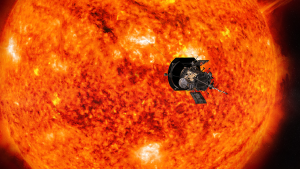NASA’s Parker Solar Probe team released a second collection of science data to the public on April 14, 2020. The release includes science data from all four of Parker Solar Probe’s instrument suites, spanning the mission’s third orbit around the Sun, which began on June 18, 2019 and completed on November 15, 2019. Also included are high-resolution measurements from the FIELDS and SWEAP instruments.
The data files and graphical displays can be accessed through NASA’s Space Physics Data Facility (SPDF) and Solar Data Analysis Center (SDAC), the APL Parker Solar Probe Gateway, and the Science Operation Centers of the four science investigation teams (the University of California, Berkeley; Princeton University; Harvard-Smithsonian Center for Astrophysics; and Naval Research Laboratory.) Data from Parker Solar Probe’s first two orbits is also available.

New findings from the mission’s first record-setting year in space were released in the Dec. 12, 2019 issue of the journal Nature and a special issue of the Astrophysical Journal Supplement Series. Parker Solar Probe’s observations reveal a complicated, active system near the Sun’s surface, including a notable phenomenon called switchbacks, which are traveling disturbances in the solar wind that cause the magnetic field to bend back on itself. These switchbacks may be a major source for the heating and acceleration of the solar wind plasma.
To date, Parker Solar Probe has completed four of its planned 24 orbits around the Sun. It will eventually travel within 4 million miles of the Sun’s surface, facing extreme heat and radiation. The mission seeks to provide new data on solar activity and how the solar corona works, which contributes significantly to our ability to forecast major space weather events that impact life on Earth. Parker Solar Probe launched in 2018 and will conduct its primary science mission until 2025.
By Justyna Surowiec
Johns Hopkins University Applied Physics Lab
